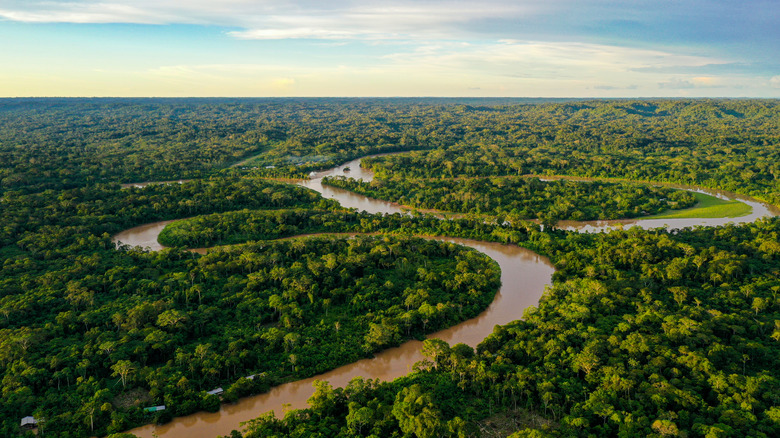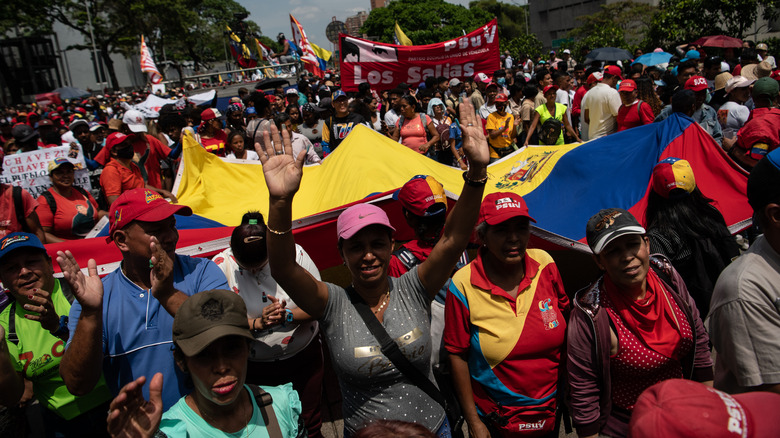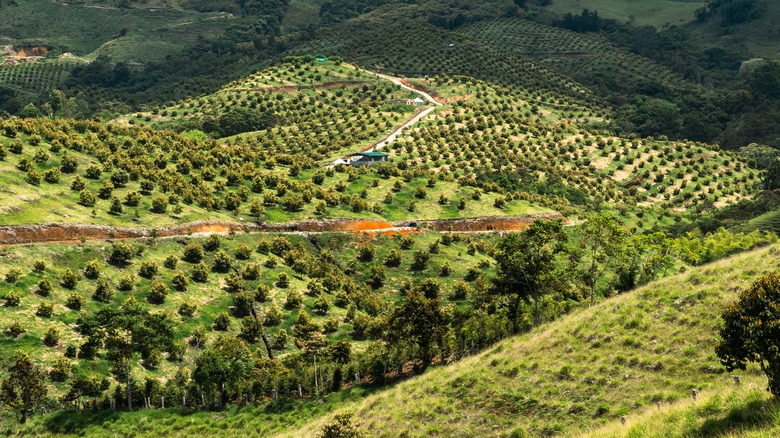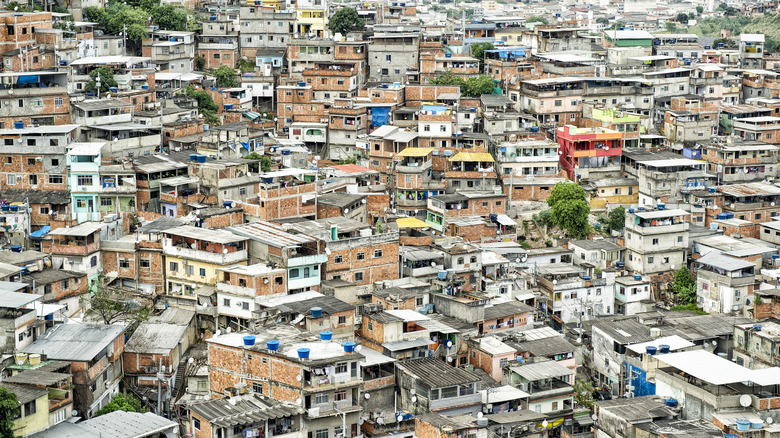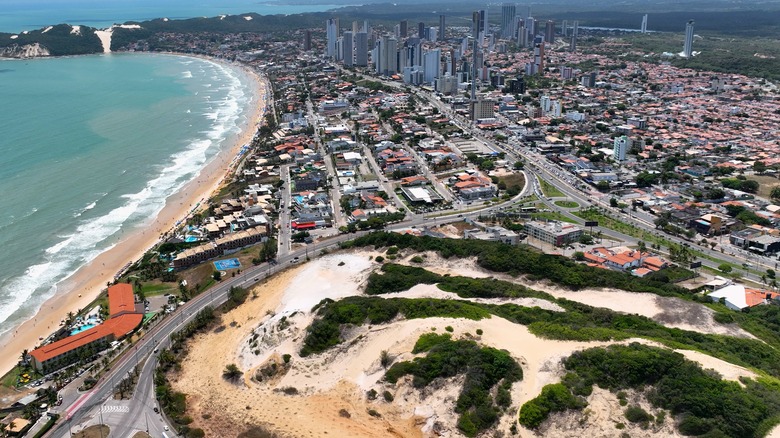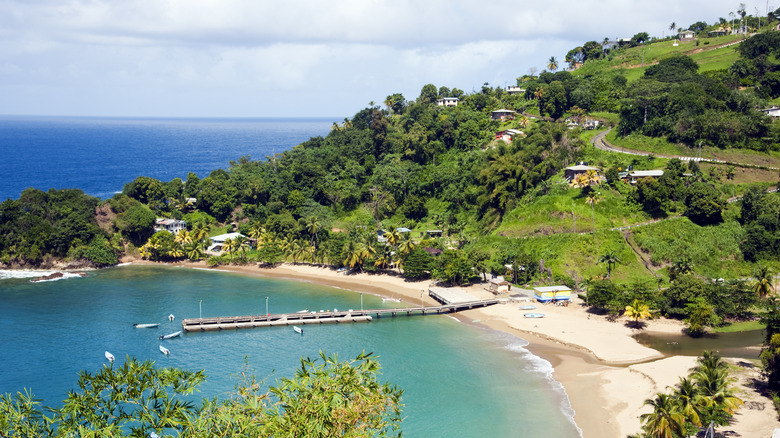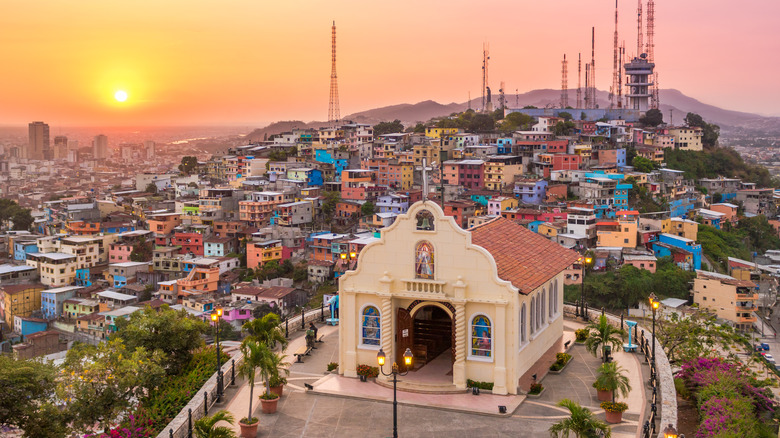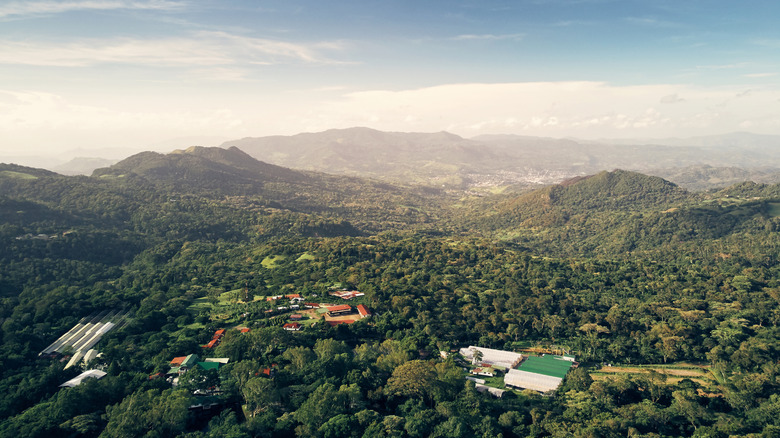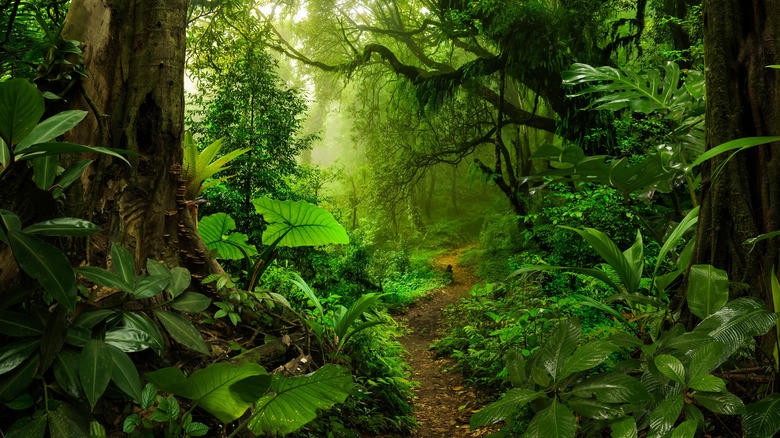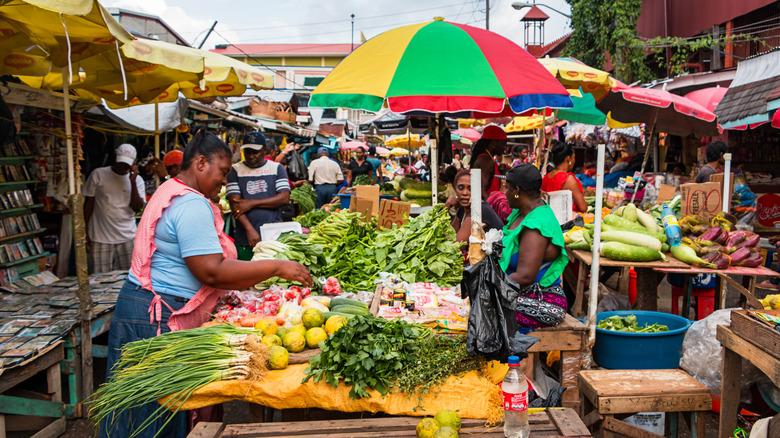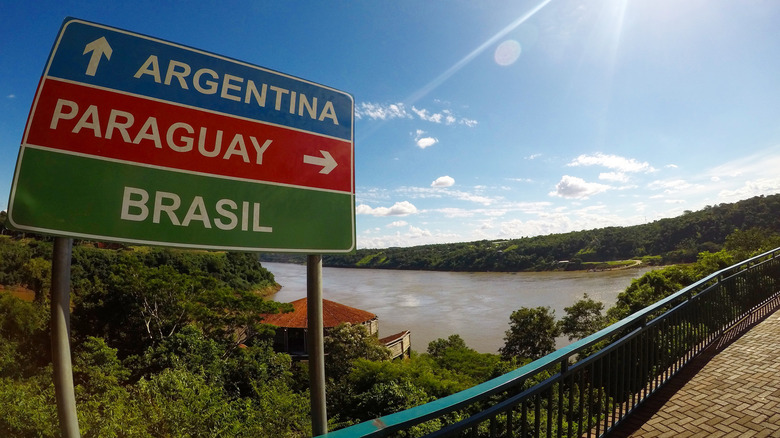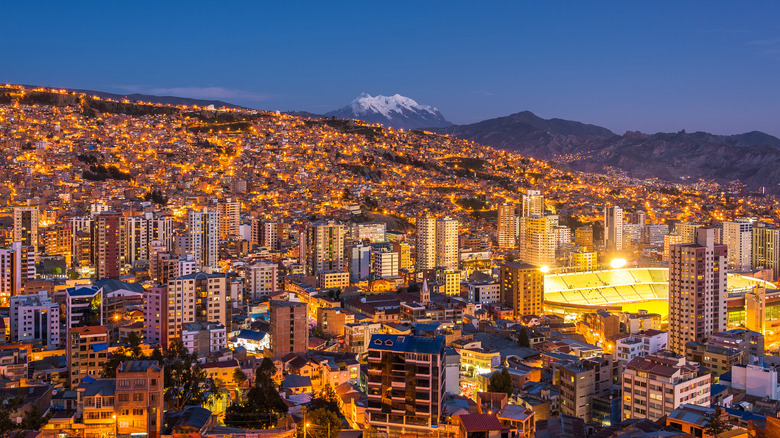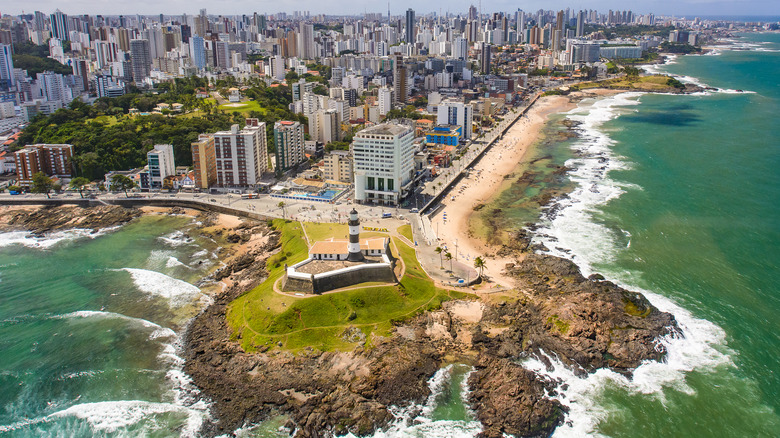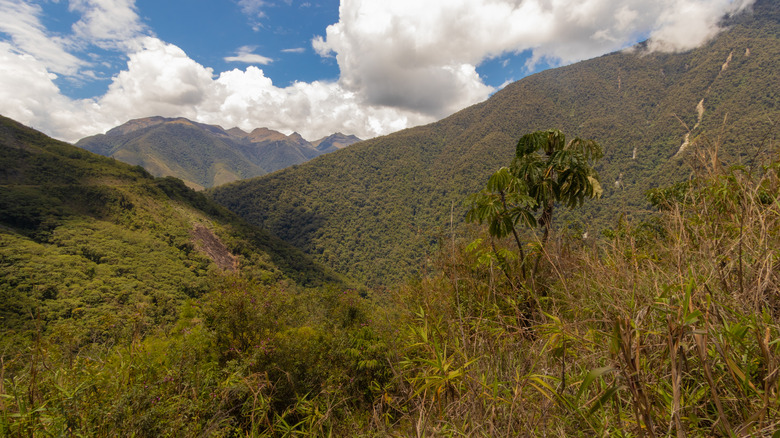Dangerous South American Destinations To Skip On Your Next Trip
Correction 10/13/2023: A previous version of this article referenced the kidnapping of a U.S. Embassy security chief in Guyana. This event happened in 2003, not 2023.
South America is a vast continent filled with diverse landscapes, attractions, and beauty. It's a land with tropical paradises to the north and penguins to the south. The Amazon Rainforest spreads across the continent's center, while the Andean Mountain Range lines the west. Unfortunately, South America isn't all about beautiful beach vacations and thrilling adventures. There are several places between the continent's picturesque coastlines and within its wild jungles, tranquil mountains, and lively cities hiding dangers that could make a visit less than ideal. Or worse, outright deadly.
When thinking of dangers in South America, many minds have a tendency to float to the exotic fauna and flora or hidden Indigenous tribes tucked into the undiscovered corners of the world, or even remote islands that are outrageously dangerous. We watched documentaries about these exact things growing up. But the reality is that few, if any, places lay undiscovered in this world of globalization. The animals and plants in South America's national parks may pose a slight risk, but these dangers aren't typically in the areas where visitors crowd. As you'll learn from this list, the most dangerous South American destinations are prone to high crime rates, political unrest, corruption, and other systemic issues that might make you think twice before adding them to your vacation itinerary.
All of Venezuela
The first dangerous South American destination on our list is the entire country of Venezuela. As you may or may not already know, Venezuela is a country in turmoil. Due to a political crisis involving discontent over what many believe to be a fraudulent presidential election in 2018 and the withering balance of power between governmental organizations, the country has seen recurring political upheaval, as BBC explains. The government response has been terrifying, with those opposing the government being held as political prisoners and protestors being arrested by the thousands.
As of now, the U.S. Department of State has issued a Do Not Travel warning to citizens who might be visiting Venezuela. With a worrying rate of violent crime and the possibility of political action breaking out on a moment's notice, visitors could find themselves caught in a bit of a pickle. The department believes the risk of wrongful imprisonment already seen with Venezuelan citizens could carry over to visiting tourists, and since there doesn't seem to be much in the way of fair judicial response, imprisonment would likely be long and unpleasant. Couple that risk with the economic breakdown and the allied phenomena of poverty leading to increased crime, as well as the unraveling of medical infrastructure, and spending time amidst the beautiful countryside views of Venezuela is no longer worth the risk.
The northwestern provinces of Colombia
Colombia has a lot going on for itself in the way of beauty and culture, but thanks to the entertainment industry's obsession with portraying the country as a land controlled by wealthy drug kingpins, that's the only way many people view this South American gem. Unfortunately, there's a little bit of truth to Hollywood's portrayals of Colombia; the country really does have some dangerous criminal organizations, and one of them calls the northwestern provinces of Colombia home.
The notorious paramilitary organization and drug gang known as the Gulf Clan operates in the Antioquia, Chocó, and Cordoba provinces of Colombia, where, according to a member of the Special Jurisdiction of Peace (via Al Jazeera), they exert more control than the local government. The gang proved this control in a dangerous fashion when armed members swarmed the cities of 11 provinces and occupied them as the prime authority for five days in early May of 2022.
The Gulf Clan warned citizens to remain in their homes under threat of deadly force. They blocked roads and effectively laid siege to the country. Why? Because their leader had been arrested and extradited to the United States, where he was sentenced to 45 years in prison. If you're wondering what that means for American tourists, well, there's a good chance the Gulf Clan isn't too happy with them right now.
Favelas in Brazil
Brazil has some of the best beaches in the world, complimented by the stunning and wild Amazon Rainforest. It also has income inequality, poverty, crime, and police brutality that make certain areas, known as favelas, dangerous for both those who live there and those who dare to visit.
Favelas are a sort of shanty town where the impoverished gather in improvised, temporary housing. You can find places like this around Rio de Janeiro, São Paulo, Salvador, and other parts of Brazil, and though you may not believe it, people do tour these areas. According to the U.S. Embassy in Brazil, visiting these areas probably isn't the best idea since they're so unpredictable. There's no guarantee of safety; not while being escorted by tour companies or with a police escort.
In fact, the police are known to be part of the problem. As Al Jazeera points out, for several years in a row, there was around one massacre per week in these areas perpetrated by the local cops, even after the Brazilian Supreme Court tried to put a stop to raids, an ineffective and brutal response to the exorbitant high crime rates on these poor communities.
Mossoro, Natal, and the state of Rio Grande do Norte, Brazil
Murder rates in the province of Rio Grande do Norte, located in the northeast of Brazil, have risen substantially since the early 2000s. While the province has some fairly high violent crime rates as a whole, two cities stand out as the most dangerous: Natal and Mossoro. On March 14, 2023, Natal, the capital of Rio Grande do Norte, saw masked gangs terrorize its streets, forcing people from their homes at gunpoint. The criminals — more aptly called "terrorists" — did some terrible things that ended in death and destruction. This run of violence swept the entire province. Busses were flipped and burned, stores and banks were attacked, homes were razed to the ground, and the night became a mark of chaos and terror in the province's history. According to The Brazilian Report, authorities believe these attacks were coordinated, so there's evidence that a seriously dangerous organization is operating in the area.
Like Natal, Mossoro is a dangerous place that visitors should avoid. While it didn't have as much destruction on the tragic March night that hit Natal so hard, Statista ranked Mossoro as the city with the most murders per capita in all of Brazil as of 2022. The city averaged over 60 murders per 100,000 people, which is preposterously high.
Trinidad and Tobago
The islands of Trinidad and Tobago have plenty to offer the potential tourist, from unspoiled, crowd-free beaches to gorgeous nature reserves, fantastic resorts, and some of the best street food in the region. However, Trinidad and Tobago also has a pretty unsavory reputation for crime. The state is beset with economic issues and corruption, with violent crime all too common, particularly in the center of the capital city, Port of Spain. The British Government warns against exploring at night, particularly in the areas of Laventille, Morvant, and Barataria.
The U.S. Department of State goes one step further, flat-out advising tourists to "reconsider travel to Trinidad and Tobago due to crime." The warning focuses primarily on violent crime and gang activity. According to travelers and locals on Reddit, the lack of relative tourist infrastructure also means visitors aren't shielded from an unspoken code of conduct that keeps tourists out of harm's way. One user commented that Trinidad is relatively safe during the day, but it is "poisoned by the plague of crime and discrimination."
Guayaquil, Ecuador
Most of Ecuador is relatively safe to visit and would make an exciting vacation destination. The U.S. State Department has only given the country a level two travel warning. To put that into perspective, the department advises U.S. tourists to exercise caution in Ecuador, whereas Venezuela has been hit with a full travel ban. This despite the unbelievable scenes in early 2024, when armed masked men took an entire TV station hostage. There are places in Ecuador where citizens are outright warned not to travel because of the level of danger hiding on their streets, and one of them is the city of Guayaquil.
Ecuador's murder rate spiked dramatically in 2023, and Guayaquil is the most dangerous city in the country. According to Reuters, the rate of murders has increased several times over since 2016. As seems typical with South and Central American countries, the crime appears to stem from the spread of drugs and drug-related gangs throughout the country. Or, at least, that's what the government believes. In the past, Ecuador has done an excellent job of staying out of the rising South American drug game but has more recently succumbed to the untoward effects of the growing cocaine trade.
Following the TV station nightmare, Ecuador's struggle with gangs has been spirally out of control. Instability and the ever-increasing influence of drug gangs (BBC referred to Guayaquil as "Ecuador's drugs hub") make for a situation that tourists might want to avoid.
Nicaragua as a whole
Nicaragua is another country on this list that visitors might want to avoid entirely. Where it's not an "avoid at all cost" country, the trouble here is problematic. The U.S. State Department has issued a "Reconsider Travel" warning for Nicaragua because it believes U.S. citizens are at risk of being wrongfully detained. Now, you might think the United States is so big and powerful and could never have its citizens arrested without due cause. That's simply untrue. There are a ton of cases of U.S. citizens being wrongfully detained around the world. And the U.S. government knows there's a real cause for concern here, in particular, due to historic trends pertaining to the current Nicaraguan regime.
If a visitor were wrongfully arrested tomorrow in Nicaragua, it wouldn't be the first time. In fact, in February 2023, 222 political prisoners were released after a negotiation with the U.S. Now, these prisoners weren't of U.S. origin — the country was simply granting them asylum — but that doesn't mean there's no danger for U.S. nationals. In 2010, American Jason Puracal was arrested and wrongfully imprisoned for two years under terrible conditions until finally being freed. Under Daniel Ortega's control, the current regime is suspected of committing multiple atrocities, including torture, wrongful executions, and more. At the end of the day, visiting Nicaragua could turn into a genuinely horrific living nightmare.
The Amazon Rainforest
The Amazon Rainforest is truly the greatest of the final wild places left on Earth. It's vast (an understatement), covering a large portion of Brazil and other South American countries. That said, the dangerous animals of the Amazon Rainforest, poisonous plants, and rare (and odd) insects can haunt your worst nightmares. It's the jungle of jungles, just begging tourists to test their mettle within its humid flora, and many do, but there are less-publicized hazards in the rainforest that might keep even brave visitors away.
If there's one dangerous animal you don't want to run into in the Amazon, it's humans. Not the Indigenous people living in jungle villages, either. It's the drug smugglers, arms dealers, illegal logging operations, and other criminal activity hiding beneath the trees. One thing criminals don't like is to be caught, and stumbling on an unlawful operation could be disastrous.
The second and more common danger in the Amazon is a little bug we all know and hate: the mosquito. The outbreaks of yellow fever in Brazil over the past few years are believed to come from mosquitos living in the Amazon, according to Away Clinic, and the disease has already claimed hundreds of lives. Furthermore, the closely related dengue fever has been observed in the same area. And where you're less likely to run into criminals in the Amazon, you'll surely meet a mosquito or two. And don't think you're safe in the water or on the beaches, either.
Georgetown, Guyana
Guyana is a small country in South America nestled between Venezuela to the west and Suriname to the south. It hasn't garnished as much popularity in Western media, so it wouldn't be surprising if you knew little about it. Being a coastal country, it has gulf beaches as beautiful as any other. Unfortunately, it also has crime issues. You might notice a trend in countries along the Gulf Coast and criminal activity, and for good reason. The open water between North and South America provides an effective route for smuggling contraband.
In particular, the city of Georgetown, which the U.S. Embassy has determined to be a critical danger, is heavy with criminal activity that would likely keep astute visitors far and away. They list from murder to assaults, robbery, and property crimes. The criminals of Georgetown historically haven't been particularly shy either. Back in April 2003, two armed men made international news when they kidnapped a security chief of the U.S. Embassy from a golf course. The embassy worker was later released, but the event remains infamous.
Frequent travelers have mixed opinions on the area's safety, with many saying that Georgetown has improved over the last two decades. Redditors seem to agree, however, that it's still smart to stay vigilant and keep an eye on your belongings.
Concepción Department of Paraguay
Continuing the theme of kidnappings brings us near the eastern edge of Paraguay in the Concepción Department. For reference, "department" is another term for "province" widely used in South American countries. Back to Concepción ... This department was where the paramilitary criminal organization known as the Paraguayan People's Army was founded, and the group is still very active here. They're known for acting like old-school mobsters by "taxing" business conducted in their territory. This goes for legal businesses and farmers as well as any smuggling or otherwise clandestine operations. And worst of all, as InSight Crime points out, the police seem absolutely scared to act against them.
The thing that's really brought this group into the media is their propensity for kidnappings that extort money from the victim's loved ones. This group mostly seems to target wealthy individuals for a politically idealistic goal. Some of their most prominent victims include the kidnapping of Óscar Denis, Paraguay's former vice president, following a military action that took the lives of two young girls, a police officer taken for leverage in a prisoner exchange, the daughter of a former president, and many more. The group seems to ask for huge sums of money — think hundreds of thousands to millions of dollars — and the victims aren't always returned alive. The money extorted is believed to go to politically motivated goals.
La Paz, Bolivia
Bolivia is typically a decent place to visit under normal conditions. Tourists can enjoy the views from the Andes and smaller mountain ranges, visit the Uyuni Salt Flat (a seriously fun family-friendly South American adventure), and experience the culture while touring through the countryside. Unfortunately, Bolivia is in the middle of political tensions that make it potentially dangerous for visitors wanting to sample everything Bolivia has to offer. At the center of these tensions is the capital city of La Paz.
It's believed that the political system in Bolivia is subject to fraud and candidate stacking, according to Human Rights Watch. Judicial candidates are fed to the masses on a set ballot, forcing voters to pick from a predetermined list. Well, this sort of system has a way of breeding political corruption if one doesn't already consider the stacking of candidates to be corrupt. Anyway, one of these judges had Luis Fernando Camacho, a Bolivian governor, held on charges of terrorism, and members of the governor's political party have been countering this action with protests and violent riots. Why is La Paz specifically dangerous? It's the seat of governmental power, much like Washington, D.C., in the United States, and political actions can break out at any moment.
More general protests against corruption and the need for judicial independence have been breaking out around the country as well. Since it doesn't look like things will cool off until things change in Bolivia, La Paz might not be the safest place to visit for a while.
Salvador, Brazil
Up until recently, Salvador held the unwanted title of Brazil's murder capital, and that's saying something. Brazil has one of the highest concentrations of violent towns of any country in the world, let alone South America.
As InSight Crime explains, Salvador is home to a number of organized crime groups, which have only increased since 2015 and were likely brought in by a growing drug trade. These gangs clash. Territorial disputes and a drive to corner black market enterprises put citizens and visitors in harm's way, as there's always a chance of innocent bystanders getting caught in the crossfire. Let's face it: criminal gangs aren't exactly known for their discretion and tender hearts for those who happen to be in the wrong place at the wrong time.
It was once believed that Salvador was the most violent city in all of South America, and even if others have overtaken it in that respect, the violence still wages on. It's unclear if recent death tolls have decreased or if those deaths have simply switched sides as violent police raids have ended in deadly shootouts. Either way, Salvador probably isn't the place you want to take your family on a South American getaway.
VRAEM, Peru
Peru is one of the most popular countries in South America, and it isn't difficult to understand why. The Inca Trail and Machu Picchu get most of the attention, but that famous experience is just the tip of a tremendous iceberg. For one, Lima's restaurant scene is one of the best on the planet, let alone the continent. However, visitors should exercise caution in Peru, especially at night. Tourists are advised against going out alone once the sun goes down, although incidents of crime during the day aren't uncommon.
Another aspect of travel in Peru to be aware of is the quality of the roads. Many roads in Peru are of poor quality, and safety conditions are lacking, which, coupled with aggressive drivers, makes for a particularly troubling situation. Furthermore, the British Government advises against all travel to the Loreto Region on the border with Colombia, as well as the Valley of the Apurimac, Ene, and Mantaro Rivers (VRAEM), primarily because of terrorism, organized crime, and the narcotics trade. It is here that Shining Path, the far-left terrorist group that controls most of the cocaine production and has a well-documented history of brutality, are most active. 37 districts in the VRAEM have been in a state of emergency for well over a decade, and citizens are often caught in the crossfires of the armed groups fighting for local control.
